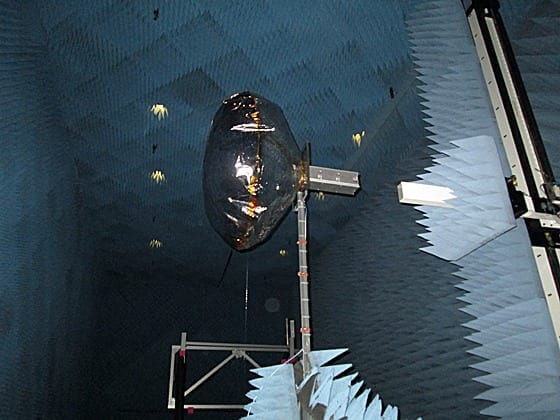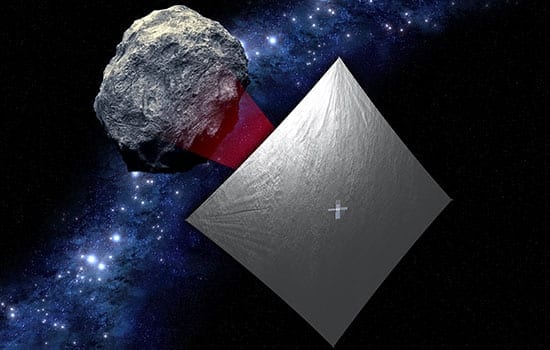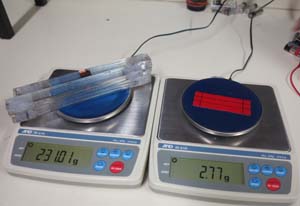
Design inflates with a powder that turns into gas.
The future of satellite technology is getting small — about the size of a shoebox, to be exact. These so-called “CubeSats,” and other small satellites, are making space exploration cheaper and more accessible: The minuscule probes can be launched into orbit at a fraction of the weight and cost of traditional satellites.
But with such small packages come big limitations — namely, a satellite’s communication range. Large, far-ranging radio dishes are impossible to store in a CubeSat’s tight quarters. Instead, the satellites are equipped with smaller, less powerful antennae, restricting them to orbits below those of most geosynchronous satellites.
Now researchers at MIT have come up with a design that may significantly increase the communication range of small satellites, enabling them to travel much farther in the solar system: The team has built and tested an inflatable antenna that can fold into a compact space and inflate when in orbit.
The antenna significantly amplifies a radio signal, allowing a CubeSat to transmit data back to Earth at a higher rate. The distance that can be covered by a satellite outfitted with an inflatable antenna is seven times farther than that of existing CubeSat communications.
“With this antenna you could transmit from the moon, and even farther than that,” says Alessandra Babuscia, who led the research as a postdoc at MIT. “This antenna is one of the cheapest and most economical solutions to the problem of communications.”
The team, led by Babuscia, is part of Professor Sara Seager’s research group and also includes graduate students Benjamin Corbin, Mary Knapp, and Mark Van de Loo from MIT, and Rebecca Jensen-Clem from the California Institute of Technology. The researchers, from MIT’s departments of Aeronautics and Astronautics and of Earth, Atmospheric and Planetary Sciences, have detailed their results in the journal Acta Astronautica.
‘Magic’ powder
An inflatable antenna is not a new idea. In fact, previous experiments in space have successfully tested such designs, though mostly for large satellites: To inflate these bulkier antennae, engineers install a system of pressure valves to fill them with air once in space — heavy, cumbersome equipment that would not fit within a CubeSat’s limited real estate.
Babuscia raises another concern: As small satellites are often launched as secondary payloads aboard rockets containing other scientific missions, a satellite loaded with pressure valves may backfire, with explosive consequences, jeopardizing everything on board. This is all the more reason, she says, to find a new inflation mechanism.
The team landed on a lighter, safer solution, based on sublimating powder, a chemical compound that transforms from a solid powder to a gas when exposed to low pressure.
“It’s almost like magic,” Babuscia explains. “Once you are in space, the difference in pressure triggers a chemical reaction that makes the powder sublimate from the solid state to the gas state, and that inflates the antenna.”
The Latest Bing News on:
CubeSats
- Rocket Lab prepares back-to-back launches featuring additively manufactured rocket engineson April 30, 2024 at 7:43 am
Rocket Lab USA is preparing two back-to-back Electron launches to deploy NASA’s PREFIRE mission featuring the AM Rutherford engine.
- CubeSat Challenge by NASA Advances Space Propulsion Technologyon April 30, 2024 at 6:58 am
The Cube Quest competition, initiated by NASA in 2015, has successfully galvanized citizen scientists and private entities across the nation to engage in advancing space exploration technologies. With ...
- Pakistan’s historic lunar mission to be launched on Fridayon April 30, 2024 at 6:38 am
Pakistan is set to embark on a ground-breaking lunar mission, as the country's historic ICUBE-Q satellite prepares for launch on Friday. The satellite will be carried aboard China's Chang'E6 ...
- Pakistan’s historic lunar mission to be launched on May 03on April 30, 2024 at 4:57 am
Pakistan's historic lunar mission (ICUBE-Q) will be launched on May 03 (Friday) at 1250 PST on board China's Chang'E6 from Hainan, ...
- NASA And ESA Prepare For Close Approach Of Near Earth Object Apophison April 30, 2024 at 12:59 am
NASA and the European Space Agency (ESA) are preparing for the close approach of near-Earth object, asteroid 99942 Apophis. In 2029, Apophis – believed to be one of the most hazardous asteroids to ...
- Rocket Lab Prepares Back-To-Back Launches For Climate Change Research Mission For NASAon April 29, 2024 at 1:53 pm
Rocket Lab USA, Inc. (Nasdaq: RKLB) ("Rocket Lab" or "the Company"), a global leader in launch services and space systems, today announced it is preparing two back-to-back Electron launches to deploy ...
- Launch Date Set for NASA’s PREFIRE Mission to Study Polar Energy Losson April 29, 2024 at 12:00 am
NASA and Rocket Lab are targeting no earlier than Wednesday, May 22, 2024, for the first of two launches of the agency’s PREFIRE (Polar Radiant Energy in the Far-InfraRed Experiment) mission to study ...
- A new era: Ariane 6 maiden launch campaign...on April 27, 2024 at 12:03 pm
On July 5, 2023, the Ariane 5 launch vehicle took flight for the last time, thus ending a storied 27-year career for what was Europe’s first heavy-lift rocket. Nearly ten months later, Arianespace is ...
- U of A set to launch student-led satellite missionon April 27, 2024 at 10:00 am
A University of Arizona student-led and built satellite will be launched into space. If the inflatable antenna works correctly, other missions will use it.
- Starlink Cubesatson August 30, 2022 at 8:13 am
A new SpaceX Starlink launch is about to happen before August ends. Here's why this mission is a big deal for the Falcon 9 first stage.
The Latest Google Headlines on:
CubeSats
[google_news title=”” keyword=”CubeSats” num_posts=”10″ blurb_length=”0″ show_thumb=”left”]
The Latest Bing News on:
Inflatable antenna
- U of A set to launch student-led satellite missionon April 27, 2024 at 10:00 am
A University of Arizona student-led and built satellite will be launched into space. If the inflatable antenna works correctly, other missions will use it.
- Woman speaks out after dust devil lifts inflatable jumper 100 feeton April 23, 2024 at 9:26 am
A California homeowner is speaking out after a dust devil sent a backyard bounce jumper up in the air and a trampoline flying.
- Jason Kelce loses his Super Bowl ring after stunt involving a pool of chilion April 17, 2024 at 4:59 pm
In Wednesday’s episode of the New Heights podcast, former Philadelphia Eagles center Jason Kelce revealed that his Super Bowl ring is officially gone. The podcast held an event at the University of ...
- What To Do If You're Lost At Seaon March 9, 2024 at 6:11 am
To activate a PLB, remove any protective covers, extend the antenna if applicable ... you're going to have to improvise — look for things like inflatable pool noodles, foam cushions from seating, or ...
- What it takes to build a next-generation observatoryon January 27, 2024 at 6:14 am
From rats chewing at fiber optic lines to inflatable tents to keep out the 100-degree heat ... The Square Kilometer Array is an upcoming radio astronomy observatory that includes antennas built over ...
The Latest Google Headlines on:
Inflatable antenna
[google_news title=”” keyword=”inflatable antenna” num_posts=”10″ blurb_length=”0″ show_thumb=”left”]










